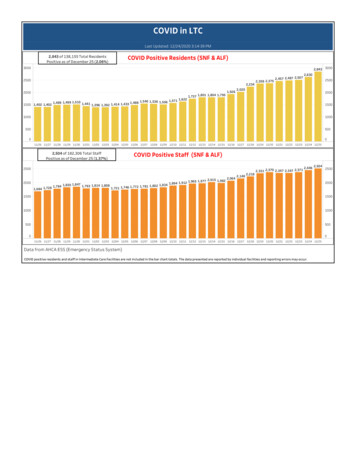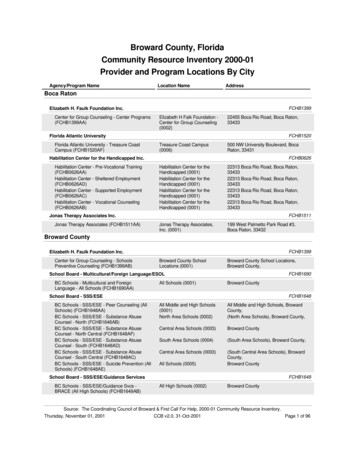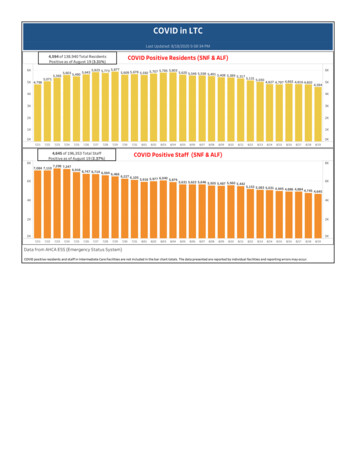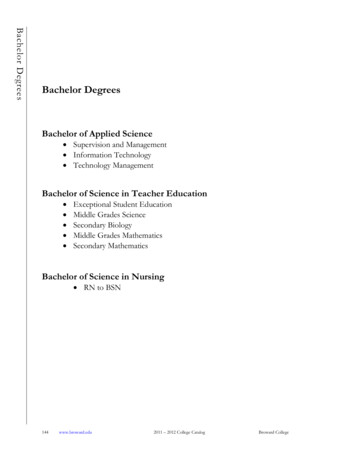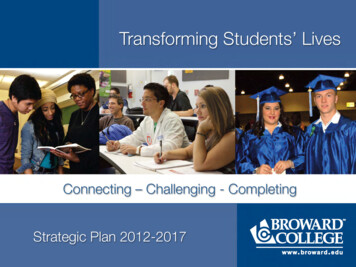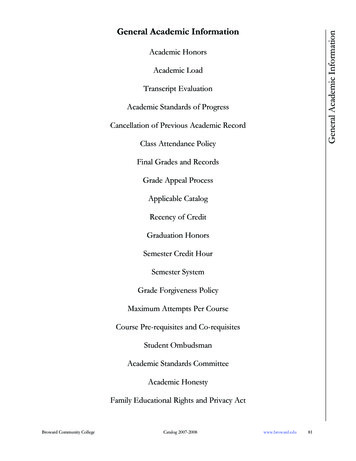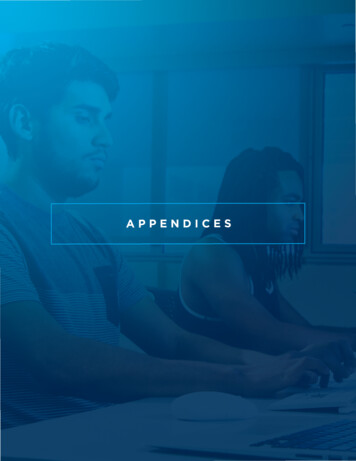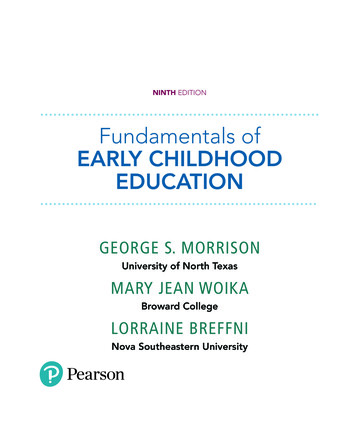
Transcription
NINTH EDITIONFundamentals ofEARLY CHILDHOODEDUCATIONGEORGE S. MORRISONUniversity of North TexasMARY JEAN WOIKABroward CollegeLORRAINE BREFFNINova Southeastern UniversityA01 MORR0519 09 SE FM.indd 108/12/18 2:38 PM
Director and Publisher: Kevin DavisPortfolio Manager: Aileen PogranManaging Content Producer: Megan MoffoPortfolio Management Assistant: Maria FelibertyDevelopment Editor: Alicia Reilly SantamariaExecutive Product Marketing Manager: Christopher BarryExecutive Field Marketing Manager: Krista ClarkManufacturing Buyer: Deidra HeadleeCover and Interior Design: Pearson CSCCover Art: FatCamera/E /Getty ImagesMedia Producer: Daniel DwyerFull Service Vendor: Pearson CSCFull Service Project Management: Pearson CSC, Emily Tamburriand Mohamed HameedPrinter/Binder: LSC Communications, Inc.Cover Printer: Phoenix ColorText Font: ITC Garamond StdCredits and acknowledgments for material borrowed from other sources and reproduced, with permission, in this textbook appear on theappropriate pages within the text.Copyright 2020, 2016, 2013 by Pearson Education, Inc. 221 River Street, Hoboken, NJ 07030. All rights reserved. No part of thispublication may be reproduced, stored in a retrieval system, or transmitted, in any form or by any means, electronic, mechanical, photocopying,recording, or otherwise without the prior written permission of the publisher. Printed in the United States. To obtain permission(s) to usematerial from this work, please visit htmlLibrary of Congress Cataloging-in-Publication DataNames: Morrison, George S., author. Woika, Mary Jean, author. Breffni,Lorraine, author.Title: Fundamentals of early childhood education / George S. Morrison,University of North Texas, Mary Jean Woika, Broward College, LorraineBreffni, Nova Southeastern University.Description: 9th edition. Hoboken : Pearson, [2018] Includesbibliographical references and index.Identifiers: LCCN 2018042709 (print) LCCN 2018043195 (ebook) ISBN9780135201404 (ebook) ISBN 9780135240519 ISBN 0135240514Subjects: LCSH: Early childhood education—United States.Classification: LCC LB1139.25 (ebook) LCC LB1139.25 .M67 2018 (print) DDC372.21—dc23LC record available at https://lccn.loc.gov/2018042709ISBN 10:0-13-524051-4ISBN 13: 978-0-13-524051-9A01 MORR0519 09 SE FM.indd 208/12/18 2:38 PM
For Betty Jane, whose life is full of grace and whose heart is full of love.To my family: Michael, Belinda, William, and Christopher. My reasons why.For Érin and Niamh—my inspiration.A01 MORR0519 09 SE FM.indd 308/12/18 2:38 PM
ABOUT THE AUTHORSGEORGE S. MORRISON is Professor Emeritus of early childhood education at the University of North Texas, where he taught early childhood education anddevelopment to undergraduates and mentored master’s and doctoral students. He is anexperienced teacher and principal in the public schools. Professor Morrison’s accomplishments include a Distinguished Academic Service Award from the PennsylvaniaDepartment of Education, Outstanding Service and Teaching Awards from Florida International University, and the College of Education Faculty Teaching Excellence Awardat the University of North Texas. His books include Early Childhood Education Today,fourteenth edition; Fundamentals of Early Childhood Education, ninth edition; andTeaching in America, fifth edition. Professor Morrison has also written books about theeducation and development of infants, toddlers, and preschoolers; child development;the contemporary curriculum; and parent, family, and community involvement.Dr. Morrison is a popular author, speaker, and presenter. His research and presentations focus on the globalization of early childhood education; the influenceof contemporary educational reforms on education; and ways to best educate earlychildhood teachers for the classrooms of today.Professor Morrison withmentor teacher WendySchwind, intern MeaganBrewer, and children atCaprock Elementary, Keller,(TX) ISD. Professor Morrisonregularly supervisesuniversity interns andparticipates in manyschool-based activities.MARY JEAN WOIKA has worked in early childhood education and early childhood special education for more than 30 years. She is currently an assistant professorand program manager at Broward College. In addition to teaching, her responsibilitiesat the college include mentoring practicum students in their early childhood classroomsthroughout Broward County, Florida, and mentorship to the North Campus Lab School.Ms. Woika has coauthored a textbook and trainee’s manual, All About Child Care andivA01 MORR0519 09 SE FM.indd 408/12/18 2:38 PM
ABOUT THE AUTHORS vEarly Education, which was developed to be used in the training of child developmentassociation (CDA) students, and contributed chapters to Early Childhood EducationToday, fourteenth edition.Before coming to Broward College Ms. Woika was a child care director, an earlyinterventionist, an early childhood special education teacher, a behavior consultant,and an inclusion specialist in an outreach program. She has taught college coursesin Pennsylvania, Colorado, Massachusetts, and Florida, in face-to-face, blended, andonline formats. Ms. Woika has sat on several state and county early childhood education committees.Professor Woika (right) is withteacher Taunsha Jones and children from the Broward CollegeLab School (Florida). Besidesbeing a teacher at the Lab School,Taunsha is one of Professor Woika’sstudents in the A.S. Early Childhood program at Broward College.Professor Woika provides ongoingsupport to the Lab School whereher students complete practicumhours and conduct observations.LORRAINE BREFFNI is the Executive Director of Early Childhood and Parenting Institutes at Nova Southeastern University’s (NSU) Mailman Segal Center for HumanDevelopment. She is also Affiliate Faculty at NSU’s Fischler College of Education. Dr.Breffni directly supervises three early childhood programs, including an infant andtoddler program; a preschool program; and a parent and child education program.She has worked as an instructor/mentor for the Community Outreach initiative at theMailman Segal Center, assisting preschool teachers as they enhance emergent literacypractices in their classrooms and as they develop strategies to accommodate the needsof at-risk children and families.Dr. Breffni has coauthored the text All About Child Care and Early Education(Pearson) and its companion resource All About Child Care and Early Education: ATrainee’s Manual, and has contributed chapters to Early Childhood Education Today,fourteenth edition. She has written numerous articles for publication and has developedand taught a diverse range of academic subjects at NSU, including courses on Developmental Psychopathology, Play Therapy, Best Practice in Emergent Literacy, and BestPractice in Prekindergarten Curriculum.Dr. Lorraine Breffni is withCaesar, Kaylee, and Kavirfrom the Family CenterPreschool at Nova Southeastern University’s MailmanSegal Center. Lorraine supervises a range of early learningprograms on the universitycampus, and participates inlocal and national advocacyinitiatives to support campus-based programs.A01 MORR0519 09 SE FM.indd 508/12/18 2:38 PM
PREFACEChanges are sweeping across the early childhood landscape, transforming our profession before our eyes! These changes create exciting possibilities for you and all earlychildhood professionals. We discuss these changes in every chapter of Fundamentals ofEarly Childhood Education, which is designed to keep you current and on the cuttingedge of early childhood teaching practices.Changes in early childhood education and development bring both opportunitiesand challenges. Today you have endless opportunities to participate in the ongoingre-creation of the early childhood profession. In fact, creating and re-creating the earlychildhood profession is one of your constant professional roles. In turn, this meansthat almost every day, you have to re-create yourself as an early childhood professional.Fundamentals of Early Childhood Education helps you achieve this professional goal.Meeting the challenges involved in reforming the profession will require collaboration,hard work, and constant dedication to achieving high-quality education for all children. We hope you will take full advantage of these opportunities to help all childrenlearn the knowledge and skills they need to succeed in school and in life. We believethat how you and we respond to the opportunities in front of us today will determinethe future of early childhood education. Fundamentals of Early Childhood Educationwill help you learn what it takes to understand and teach young children and how toprovide the support they and their families need and deserve.NEW TO THIS EDITIONThe ninth edition of Fundamentals of Early Childhood Education includes both newand highly revised content: The ninth edition includes a new chapter on technology, Technology Today: Children, Families, and You. This chapter focuses on helping early childhood professionals integrate technology into their teaching and learning with confidence.Specific “how to” topics include coding, blogging, tweeting, and integrating iPads,video conferencing, and smart boards into classroom practice. A special featureexplains how to use technology to keep children with autism safe. Informationabout assistive technology enables early childhood educators to respond to theneeds of all children in today’s diverse and inclusive classrooms. Every chapter includes expanded discussions, information, ideas, and practical activities on how to accommodate the needs of diverse learners in the inclusive classroom. The text includes several new Professionalism in Practice features, includingTechnology in the Kindergarten; Supporting Military Families: The Importance ofHigh-Quality Child Care; How to Plan a STEM Curriculum for Infants and Toddlers;and Learning to Live Together—Creating Community at School. Each chapter includes an expanded focus on the diversity of American societyand the corresponding impact on teaching and learning in the early classroom.Contemporary topics include how to respond to the needs of immigrant children;how to teach children from diverse cultural backgrounds and languages; how toviA01 MORR0519 09 SE FM.indd 608/12/18 2:38 PM
PREFACE viiteach children of poverty and diverse socioeconomic backgrounds; and the effectsof poverty on children’s learning.Chapter 13 includes expanded discussions and information on ways to better appreciate and support the needs of diverse families, including LGBTQ families, militaryfamilies, multigenerational families, and families with incarcerated members.New Applying Research to Practice features include When the Opioid Crisis HitsHome; Children of Loss and Separation; and Safe Practices for Infants and Toddlers.The text offers many practical ideas and suggestions for how to integrate engineering into STEM-focused activities. It emphasizes the importance of STEM educationfor under-served groups including infants and toddlers and girls, including information on “engineering for all.”All content is based on contemporary research and explores up-to-the-momentissues including the separation of children from their parents through immigration,divorce, incarceration, and foster care.Every chapter includes evidence-based practices supported by up-to-date researchand documentation. All research is no older than the years (2017–2018). Fundamentals of Early Childhood Education is contemporary and current.The ninth edition promotes inclusivity throughout the text. It is inclusive in termsof children, families, cultures, programs, schools, and teachers. No one-size-fits-allapproach is possible in early childhood education, so appreciation for and tolerance of diversity are placed front and center in the text.Expanded discussions focus on the importance of mental health and the role thatit plays in children’s well-being. The text provides ideas and suggestions for howteachers can support all children’s mental health.Every chapter features an expanded emphasis on providing the reader with authentic, practical ideas, suggestions, and activities for how to translate text content intoclassroom practices. All major headings conclude with a “What Does This Mean forYou?” list of practical, teacher-tested suggestions for applying theory to practice.Every chapter includes two new video-based Application Exercises. These exercisespresent the reader with a video illustrating child growth and development, teaching, and/or learning in action. An open-ended question asks the student to examinethe video critically and respond using evidence from the video and understandingof chapter concepts. Feedback is provided for support or to compare students’answers with that of an experienced teacher. Examples include meeting the needsof English learners and supporting early literacy.THEMES THROUGHOUT THE TEXTThe ninth edition of Fundamentals of Early Childhood Education integrates nine critical themes that are foundational to the field of early childhood education today.1. The importance of all children’s language and literacy development and competency.As more school districts require children to read on grade level by grade 3, you mustknow how to promote children’s reading achievement so that all children can learnand be successful. In addition, to help you meet the needs of the increasing numberof children from diverse cultures who are English learners, we provide many instructional practices and examples that enable you to confidently teach all children.2. The welcoming and support of the growing number of children from diverse familiesincluding those with LGBTQ parents, military families, multigenerational families,A01 MORR0519 09 SE FM.indd 708/12/18 2:38 PM
viiiPREFACE3.4.5.6.7.8.9.grandparent-headed families, and families with incarcerated parents. These demographic shifts have many implications for your teaching and children’s learning.Throughout the text, we provide specific pedagogical practices to assure that allchildren and all families are welcomed and supported.The importance of developmentally appropriate practices (DAP) and the applicationof these practices to all aspects of early childhood programs and classroom activities. In keeping with today’s emphasis on academic achievement, Fundamentals ofEarly Childhood Education anchors your professional practice in DAP, beginningin Chapter 1, and provides you with step-by-step strategies for helping all childrenlearn in developmentally appropriate ways.The effects of poverty and low socioeconomic status on children and their families.Today, more children and families than ever before live below the poverty line.Many children come to school unprepared to meet the challenges of preschool orkindergarten. Fundamentals of Early Childhood Education helps you educate allchildren and learn how to close the achievement gaps that exist between childrenin poverty and their more economically advantaged peers.The integration of the fields of special education and early childhood e ducation.Increasingly, special education practices influence early childhood practices. Fundamentals of Early Childhood Education helps you understand the interwovennature of these two fields and appreciate how this integration provides enhancedopportunities for both you and the children you teach in your inclusive classroom.School readiness. How to help families get their children ready for school and howto promote children’s school readiness is at the forefront of issues facing societytoday. Fundamentals of Early Childhood Education provides you with helpful information and strategies that enable you to close the readiness gaps that exist acrossethnic, gender, linguistic, and socioeconomic backgrounds.The integration of STEAM (science, technology, engineering, arts, and mathematics)subjects into the curriculum, with an emphasis on engineering for all students. STEAMsubjects are considered to be of great importance by the nation’s business leaders, andthey constitute the foundation for providing a well-trained and educated workforce.A renewed emphasis on providing for children’s mental health growth and development. In the wake of well-publicized school shootings (e.g., the Parkland HighSchool shooting) and other violent tragedies across the United States (e.g., the LasVegas mass shooting), society is demanding that the nation’s schools provide forchildren’s healthy social and emotional development. Society needs children whoare socially and emotionally healthy.The use of technology to support children’s learning. Contemporary teachers aresavvy users of technology to promote children’s learning and their own professional development. Fundamentals of Early Childhood Education helps you gainthe technological skills you need to teach in today’s classroom. Practicing professionals offer practical examples of how to integrate and use technology in teachingand learning in your classroom.TEXT FEATURESFundamentals of Early Childhood Education, ninth edition, includes numerous featuresdesigned to illustrate developmentally appropriate practice and provide a frameworkfor you to master, reflect on, and apply chapter content to your professional practice.Here are a few things to look for:A01 MORR0519 09 SE FM.indd 808/12/18 2:38 PM
PREFACE ixDynamic Chapter Content. Chapter content is organized around essential learningoutcomes, designed to measurably boost your understanding. Chapter-opening learning outcomes. Clarifying exactly what you will learn in thechapter, these learning outcomes align with the major text sections of the chapter.Reader-Friendly Content Presentation. The ninth edition is a student/reader-friendlytextbook. The content presentation helps you focus on what’s relevant by breakingup the reading into manageable sections that are clear, concise, and understandable. Key terms are highlighted and defined, enabling you to learn, master, and use theknowledge and language of your profession. Key words and terms are printed inthe text margin where they occur and in an end-of-text Glossary. “What Does This Mean for You?” and “What Can You Do?” teaching suggestions,found in all the major sections of every chapter, offers practical, teacher-testedideas, examples, and activities for you to apply to your teaching and learning asyou work with young children and their families. In the RevelTM version, Check Your Understanding multiple-choice quizzes arefound at the end of every major chapter section. They are followed by immediate,specific feedback to help you determine whether you understand fundamentalconcepts covered in the section and have achieved the learning outcome.Authentic Developmentally Appropriate Practices. These practices are highlightedin features contributed by early childhood educators from around the country. Professionalism in Practice. Teachers’ authentic voices play a major role in illustrating authentic practices. In the Professionalism in Practice features (found inevery chapter), practicing teachers explain their philosophies, beliefs, and programpractices. These teachers mentor you as they relate how they practice early childhood education. Among the contributors are professionals who are Teachers ofthe Year, have received prestigious awards, and have national board certification. Professionalism in Practice: Competency Builder. The Professionalism in Practicefeatures that are labeled as Competency Builders provide instructional practices thatcan help you move from theory to practice. They are designed to build your competence and confidence in performing essential teaching tasks, in a step-by-step manner. Lesson and Activity Plans. Planning for teaching and learning constitutes animportant dimension of your role as a professional. This is especially true today,given the emphasis on ensuring that children learn what is mandated by statestandards. The plans presented in this text enable you to look over the shoulderof experienced teachers and observe how they plan for instruction. These awardwinning teachers share plans designed to ensure that their children learn importantknowledge and skills.Features Designed to Increase Cultural Awareness Diversity Tie-In. These features, which are found in every chapter, promote inclusivity in every classroom. They include a variety of topics to create an awarenessof the uniqueness and diversity of all children and families.Features Designed to Enable Integration of Technology into Teaching Technology Tie-In. These features, which are found in every chapter, highlightspecific examples of technology use linked to chapter content. They help youbecome technologically literate, understand the options available, and use them totheir fullest extent to teach, communicate with parents, and manage a classroom.A01 MORR0519 09 SE FM.indd 908/12/18 2:38 PM
xPREFACEFeatures That Show Real Children and Early Childhood Settings in Action Portraits of Children. In a text about children, it is sometimes easy to think aboutthem in the abstract. The Portraits of Children found in Chapters 7 through 10 aredesigned to ensure that you consider children as individuals as we discuss howto teach them. The features present authentic portraits of real children from birththrough third grade from all cultures and backgrounds, enrolled in real child care,preschool, and primary-grade programs across the United States. Each portraitincludes developmental information across four domains: social–emotional, cognitive, motor, and adaptive (daily living). Accompanying questions challenge youto think and reflect about how you would provide for these children’s educationaland social needs if they were in your classroom. Newly Integrated Video Examples. Each chapter includes at least four videos thatillustrate text concepts and provide a window into the real world of teaching youngchildren. The video examples allow you to view brief examples of section conceptswithout breaking the stride of your reading, keeping you focused and on task.Activities That Help You Apply Important Concepts and Ideas Application Exercises. In the RevelTM version, These exercises (two in every chapter) present a video illustrating child growth and development, teaching, and/or learning in action. An open-ended question asks you to examine the video critically and respond using evidence from the video and your understanding of chapterconcepts. Feedback is provided for support or to compare your answer with thatof an experienced teacher. Examples include meeting the needs of English learnersand supporting early literacy. Applying Research to Practice. Fundamentals of Early Childhood Education,ninth edition, is a research-based text. A great deal of what teachers teach andhow they teach it is based on research. In every chapter of Fundamentals of EarlyChildhood Education, ninth edition, there is an Applying Research to Practice feature which highlights current research “hot topics” and provides you with specificsuggestions and activities for how you can translate today’s research and theoryinto your instructional practices.Chapter-Ending Activities for Professional Development Ethical Dilemmas. As an early childhood professional, you will face difficultchoices in your career that require you to have a solid understanding of yourethical responsibilities and best practices. To that end, each chapter includes anethical dilemma based on facts, current issues, and real-life situations faced by earlychildhood professionals today. They present difficult decisions that early childhoodprofessionals have to make. These ethical dilemmas are intended to help you builda better understanding of what it means to think like a professional and to respondappropriately in complicated and potentially compromising situations. Activities to Apply What You Have Learned. Here we revisit the chapter-openinglearning objectives and provide one activity per learning objective to help youassess your content knowledge and/or apply your understanding of that content.A01 MORR0519 09 SE FM.indd 1008/12/18 2:38 PM
PREFACE xiSUPPLEMENTS FOR INSTRUCTORSThe supplements for Fundamentals of Early Childhood Education, ninth edition,have been revised, upgraded, and made available for instructors to download onwww.pearsonhighered.com/educators. Instructor’s Resource Manual. This manual contains chapter overviews and activityideas to enhance chapter concepts. Test Bank. The Test Bank includes a variety of test items, includingmultiple-choice and short-answer items. TestGen Computerized Test Bank. TestGen is a powerful assessment generationprogram available exclusively from Pearson that helps instructors easily createquizzes and exams. Instructors can install TestGen on their personal computer(Windows or Macintosh) and create their own exams for print or online use. Theprogram contains a set of test items organized by chapter, based on this text’s content; the items are the same as those included in the Test Bank. The tests can bedownloaded in a variety of learning management system formats. PowerPoint Slides. PowerPoint slides highlight key concepts and strategies ineach chapter and enhance lectures and discussions.A01 MORR0519 09 SE FM.indd 1108/12/18 2:38 PM
ACKNOWLEDGMENTSIn the course of our teaching, service, consulting, and writing, we meet and talk withmany early childhood professionals from all around the country who are deeply dedicated to doing their best for young children and their families. We are always touched,heartened, and encouraged by the openness, honesty, and unselfish sharing of ideasthat characterize our professional colleagues. We thank all the individuals who contributed to the Professionalism in Practice features and other program descriptions. Theyare all extremely generous and are credited for sharing their personal accounts of theirlives, their children’s lives, and their programs.We are blessed to work and collaborate with our colleagues at Pearson. KevinDavis, Vice President and Publisher, gave the green light for the ninth edition and inthe beginning stages of revision was our editor. Thanks, Kevin, for your confidenceand support. We especially thank Aileen Pogran, a writer’s editor. Aileen encouragedand supported us to engage in a deep revision of Fundamentals of Early ChildhoodEducation. Aileen is always available to counsel, advise, and make better. DevelopmentEditor Alicia Reilly and Managing Content Producer Megan Moffo kept us on track andmade sure the production process ran smoothly and on schedule.Emily Tamburri, Editorial Project Manager and S.H.M. Mohamed, Senior ProjectManager fulfilled their “manager” roles professionally and efficiently, and helped usnavigate all of the challenges and responsibilities involved in the production processfrom proofing to editing to decision making to “getting everything right.” Thanks toJill Hobbs, our Copy Editor, for smoothing out all the rough edges and making Fundamentals of Early Childhood Education a more readable book.xiiA01 MORR0519 09 SE FM.indd 1208/12/18 2:38 PM
BRIEF CONTENTSCHAPTER 1You and Early Childhood EducationBecoming a Professional 2CHAPTER 2Understanding and Responding to Current IssuesContemporary Influences on Teaching and Learning 40CHAPTER 3History and TheoriesFoundations for Teaching and Learning 80CHAPTER 4Implementing Early Childhood ProgramsApplying Theories to Practice 126CHAPTER 5Observing and Assessing Young ChildrenGuiding, Teaching, and Learning 158CHAPTER 6Technology TodayChildren, Families, and You 200CHAPTER 7Infants and ToddlersCritical Years for Learning 230CHAPTER 8The Preschool YearsGetting Ready for School and Life 266CHAPTER 9Kindergarten TodayMeeting Academic and Developmental Needs 306CHAPTER 10The Primary GradesPreparation for Lifelong Success 342CHAPTER 11Educating Children with Diverse NeedsEnsuring Each Child Learns 376CHAPTER 12Guiding Children’s BehaviorHelping Children Be Their Best 406CHAPTER 13Parents, Families, and the CommunityBuilding Partnerships for Student Success 432AppendixTime Line: The History of Early Childhood EducationEndnotesGlossary462465491Name/Author IndexSubject Index499502xiiiA01 MORR0519 09 SE FM.indd 1308/12/18 2:38 PM
CONTENTSchapter 1You and Early Childhood EducationBecoming a Professional2The Early Childhood Professional and the Six Standardsof Professionalism 3The Six Standards of Professionalism 3Standard 1: Child Development and Learning 4Standard 2: Building Family and CommunityRelationships 5Standard 3: Observing, Documenting, and Assessing toSupport Children and Families 6Standard 4: Using Developmentally Effective Approachesto Connect with Children and Families 7Standard 5: Using Content Knowledge to Build MeaningfulCurriculum 8Standard 6: Becoming a Professional 10Professional Dispositions 14Developmentally and Culturally Appropriate Practiceand Essential Practices for Teaching in InclusiveEarly Childhood Classrooms 15Knowing Children 15Teaching and Learning in the Inclusive Classroom: EssentialProfessional Practices 16Core Considerations in Developmentally AppropriatePractice 17Making Developmentally Appropriate Decisions 17Teaching the Whole Child 24Pathways to Professional Development 24Ready, Set, Teach! 25The CDA Program 27Associate Degree Programs 27Baccalaureate Programs 27Alternative Certification Programs 27Master’s Degree Programs 28Your Ongoing Professional Development 28Developing a Philosophy of Education 28Read 29Reflect 29Value 30Discuss 30Write 30Evaluate 31The Expectations and Roles for Twenty-First-CenturyEarly Childhood Teachers 31Teaching in Early Childhood Today 31New Roles for Early Childhood Professionals 34Activities for Professional Development 37Ethical dilemma: “I Am Concerned About the TeachingPractice of a Coworker . . . ” 37Appli
Early Childhood Education, which is designed to keep you current and on the cutting edge of early childhood teaching practices. Changes in early childhood education and development bring both opportunities and challenges. Today you have endless opportunities to participate in the ongoing re-creation of the early childhood profession.


